James Burton (property developer)
Lieutenant-Colonel James Burton (born James Haliburton) (29 July 1761 – 31 March 1837) was the most successful and imperative property developer of Regency and Georgian London. By the time of his death in 1837, Burton had built over 3000 properties, and his buildings covered over 250 acres of central London. His imperative contribution to the development of the West End has been acknowledged by James Manwaring Baines, John Summerson, and Dana Arnold. Steen Eiler Rasmussen, in London: The Unique City, commended Burton's buildings, but did not identify their architect. The 21st century Oxford Dictionary of National Biography contends that Burton were 'the most successful developer in late Georgian London, responsible for some of its most characteristic architecture'.
James Burton | |
|---|---|
_at_St_Leonards-on-Sea.jpg.webp) Pyramidal Tomb of James Burton (1761 - 1837) and Burton family at St Leonards-on-Sea, England. | |
| Born | 29 July 1761 |
| Died | 31 March 1837 St Leonards-on-Sea, England |
| Education | Homeschooled |
| Occupation | Property developer, architect, businessman |
Notable work | |
| Children | 10 that survived infancy, including: |
| Parents |
|
| Relatives | |
James built the majority of the Bloomsbury district (including Bedford Square, Russell Square, Bloomsbury Square, Tavistock Square, and Cartwright Gardens); St John's Wood; Regent Street; Regent Street St. James; Waterloo Place, St. James's; Swallow Street; Regent’s Park (including the Inner Circle villas, Chester Terrace, Cornwall Terrace, Clarence Terrace, and York Terrace). James financed, patronized, and built the other projects of John Nash around Regent’s Park - most of which were predominantly designed by James's son, Decimus Burton, rather than by Nash himself - to the extent that the Commissioners of Woods described James, not Nash, as ‘the architect of Regent’s Park’. James also conceived, planned, and developed the town of St Leonards-on-Sea, which is now part of Hastings.
James was a leading member of London high society during the Georgian era and the Regency era. He was an early member of the Athenaeum Club, London, whose Clubhouse his company built to the design of his son Decimus Burton, who was the Club's 'prime member'. James was a close friend of Princess Victoria (the future Queen Victoria), and with the Duchess of Kent. He was Master of the Worshipful Company of Tylers and Bricklayers, and Sheriff of Kent. James was the father of William Ford Burton, the gunpowder manufacturer; of James Burton, the Egyptologist; of Henry Burton, the physician; and of Decimus Burton, the architect; amongst others; and the grandfather of Henry Marley Burton, the architect, and of Constance Mary Fearon, the founder of the Francis Bacon Society.
The Burton family mansion, The Holme in Regent's Park, which was built by James's company to a design by his son Decimus Burton, was described by 20th century architectural critic Ian Nairn as 'a definition of Western civilization in a single view'.

Family
James Burton was born in Strand, London, as James Haliburton, on 29 July 1761.[1][2] He was the son of William Haliburton (1731–1785),[1] a London property developer of Scottish descent,[1][2][3][4] whose family originated in Roxburghshire,[1][4] and of Mary Foster (previously Mary Johnson) (1735–1785),[5] whom his father married in 1760.[5] Mary Foster was the daughter of Nicholas Foster of Kirkby Fleetham, Yorkshire,[5][2] and William Haliburton was her second husband:[5] Mary had been previously married to a man surnamed 'Johnson'.[5] William Haliburton and Mary Foster had two sons,[1] James and another who died in infancy.[2][1][5] Burton's father William Haliburton's paternal grandparents were Rev. James Haliburton (1681–1756) and Margaret Eliott, daughter of Sir William Eliott, 2nd Baronet and aunt of George Augustus Eliott, 1st Baron Heathfield.[5] They had 7 daughters and 2 sons,[5] William (father of James), and Andrew.[5] James Burton's father William was descended from John Haliburton (1573–1627),[6] from whom Sir Walter Scott, 1st Baronet was descended on the maternal side.[7][1][6] Burton was a cousin of the Canadian author and British Tory MP Thomas Chandler Haliburton,[8] and of the British civil servant Lord Haliburton,[3][9][10] who was the first native Canadian to be raised to the Peerage of the United Kingdom.[11]
James (b.1761) was christened with the name 'James Haliburton' at Presbyterian Chapel, Soho, London.[1][5] He shortened his surname to Burton in 1794, subsequent to a dispute with his family,[7][3] between the birth of his fourth child and the birth of his fifth child.[1][6][5]
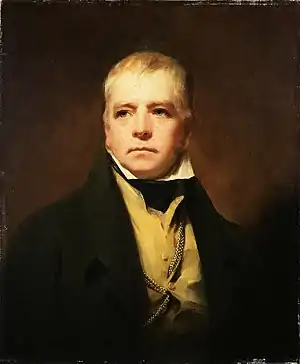
Education
James was educated at a day school in Covent Garden before being privately tutored,[12] in which he received architectural training.[2] In July 1776 he was articled to a surveyor named James Dalton,[2] with whom he remained for six years,[12] until 1782,[1] when he commenced with speculative construction projects,[1] in some of which Dalton was his partner.[2]
Significant property developments
- Bloomsbury: including Foundling Hospital Estate,[2][13] which included Brunswick Square, Guilford Street, and Mecklenburgh Square[14](on which he built 600 houses);[15] Bedford Square;[2] Bloomsbury Square[2][16] (where the remaining north side are Burton's original houses);[16] Russell Square;[2][16][13] Bedford Place;[13][16] Montague Street;[13] Tavistock Square[13][2] and Tavistock House (for himself);[2] Cartwright Gardens[13] (once named Burton Street and Burton Crescent, after him) (1785 - 1815)[13][17]
- St John's Wood[18][19]
- Regent Street:[20][2] Burton built 191 of the houses of Regent Street, and their joining archways.[21] Five of the largest blocks of Regent Street were purchased by Burton in 1817.[2] Burton's houses on Regent Street are No. 4 to No. 12; No. 17 to No. 25; No. 106 to No. 128; No. 132 to No. 154; No. 133 to No. 167; No. 171 to No. 195; and No. 295 to No. 319.[21] These were built, together with Carlton Chambers, between 1817 and 1820.[21] He also built between Leicester Street and No. 129 Swallow Street in 1820.[21] He built the east side of Regent Street in 1821, and the west side of Regent Street, specifically the part between the Quadrant and Oxford Street, and its archways, in 1822.[21] He built north of Old Burlington Street, and the east side of the street between Chapel Court and the entrance to the King Street Chapel SW1, in 1822.[21]
- Regent Street St. James (Lower Regent Street)[22][23][2]
- Waterloo Place, St. James's[24][2][21] Burton built Waterloo Place, whose facades he modelled on those of the Place Vendome in Paris, between 1815 and 1816.[21]
- Regent's Park, including the Inner Circle villas;[25][2] Cornwall Terrace[2] (1821);[20] York Terrace;[2] Clarence Terrace (1823);[26][27] Chester Terrace (1825)[2]
- The Holme, Inner Circle, Regent's Park, (1818)[2][23][20] The mansion of the Burton family, designed by Decimus Burton and built by James Burton's company.[2] It has been described as 'one of the most desirable private homes in London' by architectural scholar Guy Williams,[28] and the architectural critic Ian Nairn described it as 'a definition of western civilization in a single view'.[29]
- St Leonards-on-Sea (1827 - 1837)[2][26]
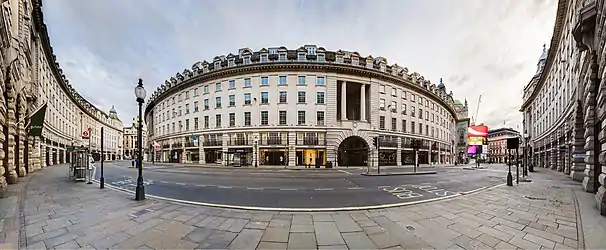
 Regent's Park, designed by his son Decimus Burton
Regent's Park, designed by his son Decimus Burton
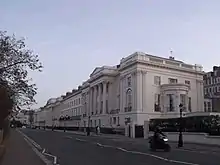 Cornwall Terrace, designed by his son Decimus Burton
Cornwall Terrace, designed by his son Decimus Burton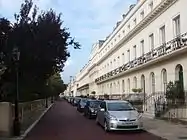 Chester Terrace, designed by his son Decimus Burton
Chester Terrace, designed by his son Decimus Burton York Terrace, designed by his son Decimus Burton
York Terrace, designed by his son Decimus Burton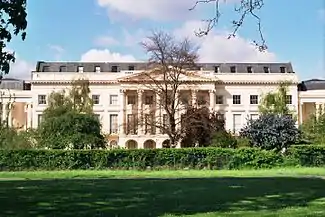 Clarence Terrace, designed by his son Decimus Burton
Clarence Terrace, designed by his son Decimus Burton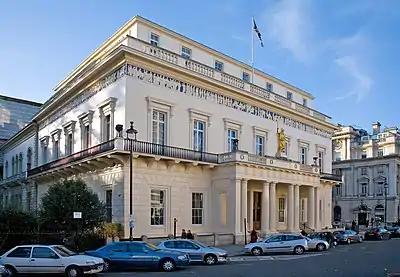 Athenaeum Club, London, designed by his son Decimus Burton, and of which he and Decimus were founders
Athenaeum Club, London, designed by his son Decimus Burton, and of which he and Decimus were founders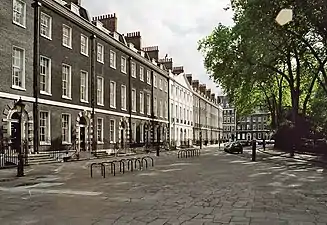
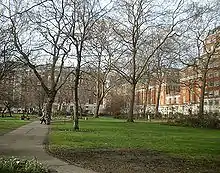
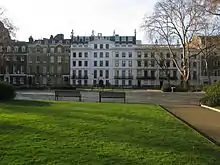
The architectural scholar Guy Williams contends, "He [Burton] was no ordinary builder. He could have put up an imposing and beautifully proportioned building, correct in every constructional detail, from the roughest of sketches tossed patronizingly at him by a "gentleman architect".[1] James vigorously industrious and quickly became 'most gratifyingly rich'.[30] Burton worked as an 'Architect and Builder' in Southwark between 1785 and 1792.[31] By 1787, Burton had established a positive reputation in Southwark: in 1786 he had built the Blackfriars Rotunda in Great Surrey Street (now Blackfriars Road) to house the Leverian Museum,[2] for land agent and museum proprietor James Parkinson;[32] this building subsequently housed the Southwark Institution.[2]
When 28 years of age, Burton made his first proposition to build on the land made available by the Foundling Hospital,[2] on which he worked from 1789.[31] He built the earliest part of the Royal Veterinary College in Camden Town in 1792 - 1793.[2]
Architectural historian Guy Williams, about James Burton (b. 1761), in 1990.[1]
Between 1790 and 1792, he asked the Governors of the Foundling Hospital for a permission to exclusively build on the whole of Brunswick Square, but they underestimated his ability, and declined to waive their principle of not allowing any one speculator to develop more than a small proportion of the ground, and granted Burton only a small part of land on the south side and part of Guildford Street.[2] Subsequently, however, he rapidly expanded this estate with further purchases until he became the most important builder on the hospital's estate,[2] and owned most of the western property: between 1792 and 1802 he built 586 houses on the estate,[2] and, at a time when other builders were struggling financially, expended over £400,000 on the estate,[2] thus bringing the total number of his constructions on the estate to nearly 600.[33] Samuel Pepys Cockerell, advisor to the Governors of the Foundling Hospital, commended Burton's excellence:
"Without such a man [James Burton], possessed of very considerable talents, unwearied industry, and a capital of his own, the extraordinary success of the improvement of the Foundling Estate could not have taken place... By his own peculiar resources of mind, he has succeeded in disposing of his buildings and rents, under all disadvantages of war, and of an unjust clamour which has repeatedly been raised against him. Mr Burton was ready to come forward with money and personal assistance to relieve and help forward those builders who were unable to proceed in their contracts; and in some instances he has been obliged to resume the undertaking and complete himself what has been weakly and imperfectly proceeded with...".[34]
The contemporary Oxford Dictionary of National Biography contends that 'there is certainly no doubt about his energy and financial acumen'.[2] Burton was vigorously industrious, and quickly became 'most gratifyingly rich'.[30] Throughout his development of the Foundling Hospital Estate, Burton was encouraged by Francis Russell, 5th Duke of Bedford, and his successor, John Russell, 6th Duke of Bedford, and by the Skinners' Company to develop the remainder of Bloomsbury, including their adjacent estates.[2] In 1800, Burton bought a portion of the London estate of the Dukes of Bedford,[30] and immediately demolished the Bedfords decaying London mansion, Bedford House,[30] on the site of which he constructed several family homes, including the houses of Bedford Place[30] and Russell Square.[2]
Style
Architectural historian Guy Williams, about James Burton (b. 1761), in 1990.[30]
In these Bloomsbury developments, Burton again demonstrated his architectural flair, as Williams describes: "James Burton became adept at relieving the monotony of long residential terraces by allowing their central blocks to project slightly from the surfaces to each side, and by bringing forward, too, the houses at each end". Williams also records that "the ironwork in a classical style in James Burton's Bloomsbury terraces was, and often still is, particularly fine, though mass produced".[30] The Bloomsbury Conservation Areas Advisory Council describes Burton's Bloomsbury terraces, "His terraces are in his simple but eloquent Neoclassical style, with decorative doorcases, recessed sash windows in compliance with the latest fire regulations, and more stucco than before".[13] Jane Austen described Burton's new area of London in Emma: "Our part of London is so very superior to most others! - You must not confound us with London in general, my dear sir. The neighbourhood of Brunswick Square is very different from all the rest".[14] In 1970, John Lehmann predicted that Burton’s Bloomsbury would soon disappear "except for a few isolated rows... to remind us of man-sized architecture in a vanished age of taste".[13] Burton exhibited his design of the south side of Russell Square at the Royal Academy Exhibition of 1800.[2] Burton's urban designs were characterized by spacious formal layouts of terraces, squares, and crescents.[2]
In 1807 Burton expanded his Bloomsbury development north, and was also involved extensively in the early development of St John's Wood.[18][19] He then left London for a project in Tunbridge Wells but returned in 1807 to build over the Skinners Company ground between the Bedford Estate and the lands owned by the Foundling Hospital, where he built Burton Street and Burton Crescent (now Cartwright Gardens), including, for himself, the Tavistock House, on ground now occupied by the British Medical Association, where he lived until he moved to The Holme in Regent's Park, which was designed for him by his son Decimus Burton.[33] Burton also developed the Lucas Estate.[35]
Burton constructed some houses at Tunbridge Wells between 1805 and 1807.[2] Burton developed Waterloo Place, St. James's, between 1815 and 1816.[2] In 1815, James Burton took Decimus to Hastings, where the two would later design and build St Leonards-on-Sea, and, in 1816, Decimus commenced work in the James Burton's office.[36] Whilst working for his father, Decimus was present in the design and construction of Regent Street St. James (Lower Regent Street).[22][23] Simultaneously, George Maddox taught Decimus architectural draughtsmanship, including the details of the five orders. After his first year of tuition by his father and Maddox, Decimus submitted to the Royal Academy a design for a bridge, which was commended by the Academy.[22]
Between 1785 and 1823, before many of his Regent's Park terraces were complete, James Burton had constructed at least 2366 houses in London.[2]
Relationship with John Nash
The parents of John Nash (b. 1752), and Nash himself during his childhood, lived in Southwark,[37] where Burton worked as an 'Architect and Builder' and developed a positive reputation for prescient speculative building between 1785 and 1792.[31] Burton built the Blackfriars Rotunda in Great Surrey Street (now Blackfriars Road) to house the Leverian Museum,[2] for land agent and museum proprietor James Parkinson.[32] However, whereas Burton was vigorously industrious, and quickly became 'most gratifyingly rich',[30] Nash's early years in private practice, and his first speculative developments, which failed either to sell or let, were unsuccessful, and Nash's consequent financial shortage was exacerbated by the 'crazily extravagant' wife, whom he had married before he had completed his training, until he was declared bankrupt in 1783.[38] To resolve his financial shortage, Nash cultivated the acquaintance of Burton, and Burton consented to patronize him.[39] James Burton was responsible for the social and financial patronage of the majority of Nash's London designs,[25] in addition to for their construction.[40] Architectural scholar Guy Williams has written, 'John Nash relied on James Burton for moral and financial support in his great enterprises. Decimus had showed precocious talent as a draughtsman and as an exponent of the classical style... John Nash needed the son's aid, as well as the father's'.[25] Subsequent to the Crown Estate's refusal to finance them, James Burton agreed to personally finance the construction projects of John Nash at Regent’s Park, which he had already been commissioned to construct:[2][40] consequently, in 1816, Burton purchased many of the leases of the proposed terraces around, and proposed villas within, Regent's Park,[2] and, in 1817, Burton purchased the leases of five of the largest blocks on Regent Street.[2] The first property to be constructed in or around Regent's Park by Burton was his own mansion: The Holme, which was designed by his son, Decimus Burton, and completed in 1818.[2] Burton's extensive financial involvement 'effectively guaranteed the success of the project'.[2] In return, Nash agreed to promote the career of Decimus Burton.[40] Such were James Burton’s contributions to the project that the Commissioners of Woods described James, not Nash, as ‘the architect of Regent’s Park’.[41] Contrary to popular belief, the dominant architectural influence in many of the Regent's Park projects - including Cornwall Terrace, York Terrace, Chester Terrace, Clarence Terrace, and the villas of the Inner Circle, all of which were constructed by James Burton's company[2] - was Decimus Burton, not John Nash, who was appointed architectural 'overseer' for Decimus's projects.[41] To the chagrin of Nash, Decimus largely disregarded his advice and developed the Terraces according to his own style, to the extent that Nash sought the demolition and complete rebuilding of Chester Terrace, but in vain.[42][2] Decimus subsequently eclipsed his master and emerged as the dominant force in the design of Carlton House Terrace,[40] where he exclusively designed No. 3 and No.4.[43]
London Legacy
James Burton's imperative contribution to the development of the West End has been acknowledged increasingly by commentators during the 20th century: including by Baines, John Summerson, Olsen, and Dana Arnold. Steen Eiler Rasmussen, in London: The Unique City, commended Burton's buildings, but did not identify their architect.[35] The Oxford Dictionary of National Biography contends that Burton were 'the most successful developer in late Georgian London, responsible for some of its most characteristic architecture',[2] and the Burtons' St. Leonards Society that he were "probably the most significant builder of Georgian London."[7]
Gunpowder manufacturer
In addition to his property development enterprises, James Burton invested greatly in the manufacture of gunpowder from 1811.[2] This enterprise was based at Powder Mills, Leigh, and was managed by Burton in partnership with his eldest son, William Ford, who directed the sales of the product from his office in the City of London.[44][45][2] The mills, which were initially known as the Ramhurst Powder Mills,[46] and later as the Tunbridge Gunpowder Works,[2] were that established in 1811 in partnership with Sir Humphry Davy, who later sold his shares to the Burton family, who became thereby the sole owners of the Works.[2][47][48][49][44] After the retirement of James Burton in 1824,[46] William Ford became the sole owner of the mills until his death in 1856,[46][47] at which point the gunpowder business to his brother, Alfred Burton JP, Mayor of Hastings.
Development of St Leonards-on-Sea
In 1827, James Burton became aware that part of the ancient Manor of Gensing, which was situated between Hastings and the Bulverhythe Marshes, was on the market and could be developed.[50] Decimus Burton advised against this prospective project of his father, which limited his supply of capital for his own development of the Calverley Estate,[50] but James ignored him, bought it, and proceeded to build St Leonards-on-Sea as a pleasure resort for the gentry.[2] James Burton designed the town 'on the twin principles of classical formality and picturesque irregularity', to be a rival to Brighton.[2] The majority of the first part of the town had been completed by 1830.[2] In 1833, St. Leonards-on-Sea was described as 'a conceited Italian town'.[2]
Personal life

During the year 1800, in which his tenth child Decimus was born, James was living at the 'very comfortable and well staffed' North House in the newly built Southampton Terrace at Bloomsbury.[30] He subsequently lived at Tavistock House, which later became the residence of Charles Dickens. Subsequent to the birth of his twelfth child, Jessy, in 1804, Burton purchased a site on a hill about one mile to the south of Tonbridge in Kent, where he constructed, to the designs of the architect Joseph T. Parkinson, in 1805,[31] a large country mansion which he named Mabledon House,[51][2] which was described in 1810 by the local authority as 'an elegant imitation of an ancient castellated mansion'.[51] The majority of the stone that Burton required for Mabledon was quarried from the hill on which it was to be built, but Burton also purchased the stone that had been released by the recent demolition of a nearby mansion, Penhurst Place.[51] Subsequent to the commencement of his residence at Mabledon, Burton employed a bailiff and a gamekeeper, hosted balls, and was shortly invested as Sheriff of Kent[51] for 1810.[2] A diary written by James Burton, wbich records his activities between 1783 and 1811, survives and is kept at Hastings Museum and Art Gallery.[52] The Burtons lived at Mabledon from 1805 to 1817.[53]
Burton was Master of the Worshipful Company of Tylers and Bricklayers in 1801 to 1802.[2] In 1804, in response to the cessation of amicable relations with the French Republic, Burton raised a 1600 strong company of volunteers, the Loyal British Artificers,[30] at his own expense, which was recruited from the large body of artificers that were in his employ,[30][2] and of which he became Lieutenant-Colonel Commandant.[30][12] In the eventuality of invasion by the French, the rallying-point of Burton's Loyal British Artificers was to be the Tottenham Court Road.[30] He attended the funeral of Horatio Nelson in 1806.[12]
Subsequently, from 1818, Burton resided at The Holme, Regent's Park, which has been described as 'one of the most desirable private homes in London',[28] which was designed as the Burton family mansion by James's son Decimus, and built by his own company.[2] The Holme was the second villa to be built in Regent's Park, and the first of those to be designed or constructed by the Burton family.[54] The hallmark of the Burton design is the large semi-circular bay that divided the principal elevation, and which extended for two storeys.[54] The original villa also had a conservatory of polygonal form, which used wrought iron glazing bars, then only recently patented, instead of the then customary wooden bars.[54] The first villa to be constructed in the park was St. John's Lodge by John Raffield.[54]
The Burton family had residences and offices at 10, 12, and 14 Spring Gardens, St. James's Park, at the east end of The Mall, where Decimus Burton constructed No. 10, 12, and 14 Spring Gardens as both his townhouse and his own office.[55][40] They also had offices at Old Broad-Street, City of London,[44] and Lincoln's Inn Fields, where Septimus Burton was a solicitor at Lincoln’s Inn,[56][9] where he trained William Warwick Burton,[57] who was a resident.[58]
During 1820, Burton, his wife, and his children dined frequently with George Bellas Greenough.[59] Greenhough and Decimus finalized their designs during numerous meetings at the opera.[59]
James Burton was an early member of the Athenaeum Club, London, as was his son, Decimus Burton,[60] who has been described as the 'prime member of the Athenaeum' by architectural scholar Guy Williams[61] who there 'mixed with many of the greatest in the land, meeting the most creative as well as those with enormous hereditary wealth'.[62]
James and Decimus Burton were 'on excellent terms' with Princess Victoria,[62] and with the Duchess of Kent.[62] The Princess and the Duchess, with several courtiers, had laid the foundation stone of a Decimus Burton School in Tunbridge Wells,[62] and, five weeks later, in autumn 1834, they had stayed, by Decimus's invitation, at James Burton's private villa at St Leonards-on-Sea, for several months, until several weeks into 1835.[63]
Elizabeth Burton died at St Leonards-On-Sea on 14 January 1837.[64] James Burton died at St Leonards-On-Sea on 31 March 1837.[64] James is buried in a distinctive pyramidal tomb in the churchyard of St Leonards-on-Sea, the town that he had designed and created, where a monument to his memory was also erected.[2]
Marriage and children
On 1 March 1783, at St. Clement Danes, Strand, London,[1] James Burton married Elizabeth Westley (12 December 1761 – 14 January 1837),[64][2] of Loughton, Essex,[1] daughter of John and Mary Westley.[5] They had six sons and six daughters,[6][5] ten of whom were alive at the time of their father's death on 31 March 1837.[2] Their first four children were all baptized at the church at which they had married, and entered in the church registers with the surname 'Haliburton':[1] however, James and Elizabeth changed their surname to 'Burton' between the birth of their fourth child and the birth of their fifth child.[1][5][7][3]
- William Ford[2][6] (11 January 1784 – 18 October 1856).[5] William Ford was named after his maternal granduncle, William Ford. He was prevented from attending university by a severe injury caused by a fall from his horse in 1806. He began farming with his father in 1807.[9] The office of the Burton family was in the City of London,[44][45] from which William Ford managed the Powder Mills, Leigh[53] - which were initially known as the Ramhurst Powder Mills,[46] and later as the Tunbridge Gunpowder Works – that he established in 1811 in partnership with his father, James Burton, and Sir Humphry Davy,[47][48][49][44][2] both of whom were early members of the Athenaeum Club, London. Subsequent to the retirement of James Burton in 1824,[46] William Ford became the sole owner of the mills until his death in 1856,[46][47] at which point the gunpowder business was transferred to his brother, Alfred Burton JP, the Mayor of Hastings. William Ford lived at St John's Wood, The Holme, and South Lodge, St. Leonards-on-Sea.[9] He never married but had two illegitimate sons:[65][5][9][57][2] Henry Marley Burton FRIBA (1821 - 1880) and William Warwick Burton[57] (d. 21 October 1861).[58][66] Henry Marley was baptized as Henry Marley on 12 Dec 1821: at his baptism, he was claimed to be the son of William Marley and Sally Marley, London neighbours of the Burtons.[57] Henry Marley had at least one son, Edgar Burton, also an architect,[67] whose daughter Adelaide was abortively married to Leopold Albu, of 4 Hamilton Place, Mayfair, the brother of Sir George Albu, between 19 August 1901 and 1915.[68] William Warwick Burton lived at Lincoln's Inn Fields,[58] where he was articled as a solicitor to his uncle, Septimus Burton (1794 - 1842)[57] of Lincoln’s Inn.[56][9] William Warwick Burton had three children, William Edgar Burton, Edmund Burton, and Jessy Burton,[69] each of whom were left property in the will of their uncle, Decimus, who never married and died without issue.[57]
- Emma Elizabeth[6] (4 August 1785 – 13 December 1785). She died from smallpox.[5]
- Eliza[2][6] (29 September 1786 – 6 February 1877).[5] She lived for a time at No. 36 Marina and later at No. 5 West Hill in St. Leonards-on-Sea. She did not marry.[2][12][9]
- James[2][6] FGS (22 September 1788 – 22 February 1862).[5] Egyptologist.[10][70][9]
- Emily[6] (10 August 1791 – 20 May 1792).[5][9]
- Jane[2][6] (4 April 1792 – 11 December 1879).[5][56][9] She married Thomas Walker[71] (who changed his surname to Wood[56] in 1817)[71] of Tonbridge, at Tonbridge, in 1812.[71] She had one son George James (1813–1831) and three daughters, Emily (1815–1892), Helen (1816–1903) and Rose Anne (born 1818).[71][56] She and her daughters lived at North Lodge, St. Leonards-on-Sea.[56][12]
- Septimus[2][6] (27 July 1794 – 25 November 1842).[5][56][9] Septimus was educated at Lincoln's Inn, where he was articled to J. W. Lyon in 1810, and, subsequently, established his legal practice.[56][6] He dealt with much of his father’s business.[6] He married Charlotte Lydia Elizabeth Middleton in 1824.[72] They had 1 son, Arthur (b.1830)[72] who married Lilian Margaret Robertson in 1860 and one son, Francis Arthur (1861–64). Septimus lived at Serle Street, Lincoln's Inn Fields. He died on 25 November 1842, and is buried at Chiswick.[72]
- Octavia[2][6] (b. 20 May 1796 - d. after March 1837)[2][5] She married Edmund Hopkinson,[73][74] a banker, at Tonbridge, in 1813.[73] No issue.[9]
- Henry[2][6] FRCP (27 February 1799 – 10 August 1849).[5] Physician who discovered the Burton line.[9] He married Mary Elizabeth Poulton (1800 - 1829) in 1826 at St. George's, Bloomsbury.[75]
- Decimus[2][6] FRS FRSA RA FSA FRIBA (30 September 1800 – 14 December 1881).[30][5] Architect.[12][9][76]
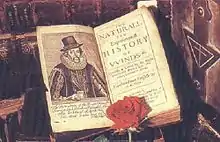 Burton 's granddaughter, Constance Mary Fearon, was the founder of the Francis Bacon Society.
Burton 's granddaughter, Constance Mary Fearon, was the founder of the Francis Bacon Society. - Alfred[2][6] (18 June 1802 – 24 April 1877)[5] JP. Mayor of Hastings, manager of the Burton estates.[6] He had architectural training,[6] and worked as Secretary to Decimus Burton[6] and to Thomas Wood (the husband of Jane Burton). In St. Leonards-on-Sea, Alfred Burton was Steward of the Races; President of the Mechanics Institute; Vice-President of the Infirmary; and Trustee of Hastings and Flimwell Turnpike. He was a member of the Queen’s Royal St. Leonards Archers.[9] He was a long-standing member of the Oriental Club, to which he donated numerous books and pictures,[77] and to which his brother Decimus and nephew Henry Marley Burton made architectural additions.[78] Alfred married Anna Delicia Adams in 1843.[79] They had one son, Alfred Henry (1845 – 1917)[79][80] of Hastings Lodge, JP, High Sheriff of Sussex in 1902, who married Ellen Amelia Dickson, and had four children, and one daughter Louisa Charlotte (1849–1873),[79] who did not marry.
- Jessy[2][6] (12 April 1804 – after 24 April 1844)[30][5][56][9] She married John Peter Fearon (1804–1873),[81][56] a lawyer of Great George Street, Westminster, in 1833.[81][12] She lived in Regent's Park.[56] She had 3 daughters, Jessy Tyndale (1834–1910),[81] Constance Mary (1835–1915),[81] and Ethel Anna (1839–1901)[81] (who married Thomas Ayscough, and had issue) and one son, Francis[82] (1837–1914),[81] (who married Julia Mary Woodward, and had issue).[12] Jessy's middle daughter, Constance Mary Fearon, was the founder of the Francis Bacon Society and author (under the pseudonym Mrs Henry Pott) of numerous books advocating the theory that Francis Bacon, 1st Viscount St. Alban was the author of the works attributed to William Shakespeare.[83]
References
- Williams, Guy (1990). Augustus Pugin Versus Decimus Burton: A Victorian Architectural Duel. London: Cassell Publishers Ltd. p. 18. ISBN 0-304-31561-3.
- "James Burton [Haliburton]", Oxford Dictionary of National Biography".
- Davies, Richard A. (2005). Inventing Sam Slick: A Biography of Thomas Chandler Haliburton. University of Toronto Press. pp. 71–73.
- "James Haliburton, formerly Burton (1788-1862), The Victorian Web". London: The Victorian Web. 2018.
- "Pedigree of Decimus Burton, The Weald Archives".
- Whitbourn, Philip (2003). Decimus Burton, Esquire: Architect and Gentleman (1800 - 1881). Royal Tunbridge Wells Civic Society. p. 9. ISBN 978-0-9545343-0-1.
- "Who were the Burtons?". The Burtons' St Leonards Society. Retrieved 18 June 2016.
- Williams, Guy (1990). Augustus Pugin Versus Decimus Burton: A Victorian Architectural Duel. London: Cassell Publishers Ltd. p. 127. ISBN 0-304-31561-3.
- Burton, James (1783–1811). "The Diary of James Burton". The National Archives. Retrieved 18 June 2018 – via Hastings Museum and Art Gallery.
- "Haliburton [Haleburton; formerly Burton], James (1788–1862), Egyptologist".
- Morgan, Henry James, ed. (1903). Types of Canadian Women and of Women who are or have been Connected with Canada. Toronto: Williams Briggs. p. 142.
- J. Manwaring Baines F.S.A., Burton’s St. Leonards, Hastings Museum , 1956.
- "The Building of Bloomsbury, Bloomsbury Conservation Areas Advisory Committee". London: Bloomsbury Conservation Areas Advisory Committee. 2018.
- Porter, Roy (2000). Russell Square. London: Penguin UK. ISBN 9780140105933.
- Clarke, Richard (2004). "Russell Square" (PDF). London: Birkbeck, University of London.
- Historic England. "Bloomsbury Square (1000210)". National Heritage List for England. Retrieved 30 January 2019.
- Williams, Guy (1990). Augustus Pugin Versus Decimus Burton: A Victorian Architectural Duel. London: Cassell Publishers Ltd. pp. 135–136. ISBN 0-304-31561-3.
- Jones, Christopher (2017). Picturesque Urban Planning - Tunbridge Wells and the Suburban Ideal: The Development of the Calverley Estate 1825 - 1855. University of Oxford, Department of Continuing Education. p. 62.
- Victoria County History: Middlesex and London. Celebrating the birth in July 1761 of James Burton, the founder of St Leonards-on-Sea and builder-developer in Bloomsbury. Accessed: 18 June 2016.
- Williams, Guy (1990). Augustus Pugin Versus Decimus Burton: A Victorian Architectural Duel. London: Cassell Publishers Ltd. p. 136. ISBN 0-304-31561-3.
- Arnold, Dana (2005). Rural Urbanism: London Landscapes in the Early 19th Century. Manchester University Press. pp. 87–88.
- Williams, Guy (1990). Augustus Pugin Versus Decimus Burton: A Victorian Architectural Duel. London: Cassell Publishers Ltd. p. 29. ISBN 0-304-31561-3.
- Williams, Guy (1990). Augustus Pugin Versus Decimus Burton: A Victorian Architectural Duel. London: Cassell Publishers Ltd. p. 41. ISBN 0-304-31561-3.
- Williams, Guy (1990). Augustus Pugin Versus Decimus Burton: A Victorian Architectural Duel. London: Cassell Publishers Ltd. p. 45. ISBN 0-304-31561-3.
- Williams, Guy (1990). Augustus Pugin Versus Decimus Burton: A Victorian Architectural Duel. London: Cassell Publishers Ltd. pp. 11–12. ISBN 0-304-31561-3.
- Williams, Guy (1990). Augustus Pugin Versus Decimus Burton: A Victorian Architectural Duel. London: Cassell Publishers Ltd. p. 137. ISBN 0-304-31561-3.
- "Entry for Burton, Decimus, in Dictionary of Scottish Architects". Retrieved 20 March 2017.
- Williams, Guy (1990). Augustus Pugin Versus Decimus Burton: A Victorian Architectural Duel. London: Cassell Publishers Ltd. p. 133. ISBN 0-304-31561-3.
- Nairn, Ian (1966). Nairn's London (first ed.). ISBN 978-0141396156.
- Williams, Guy (1990). Augustus Pugin Versus Decimus Burton: A Victorian Architectural Duel. London: Cassell Publishers Ltd. p. 19. ISBN 0-304-31561-3.
- Williams, Guy (1990). Augustus Pugin Versus Decimus Burton: A Victorian Architectural Duel. London: Cassell Publishers Ltd. p. 135. ISBN 0-304-31561-3.
- Torrens, H. S. "Parkinson, James (bap. 1730, d. 1813), land agent and museum proprietor". Oxford Dictionary of National Biography (online ed.). Oxford University Press. doi:10.1093/ref:odnb/21370. (Subscription or UK public library membership required.)
- Summerson, John (1962). Georgian London (First ed.). Pimlico.
- Williams, Guy (1990). Augustus Pugin Versus Decimus Burton: A Victorian Architectural Duel. London: Cassell Publishers Ltd. pp. 20–21. ISBN 0-304-31561-3.
- Jones, Christopher (2017). Picturesque Urban Planning - Tunbridge Wells and the Suburban Ideal: The Development of the Calverley Estate 1825 - 1855. University of Oxford, Department of Continuing Education. p. 41.
- Williams, Guy (1990). Augustus Pugin Versus Decimus Burton: A Victorian Architectural Duel. London: Cassell Publishers Ltd. p. 28. ISBN 0-304-31561-3.
- Williams, Guy (1990). Augustus Pugin Versus Decimus Burton: A Victorian Architectural Duel. London: Cassell Publishers Ltd. p. 13. ISBN 0-304-31561-3.
- Williams, Guy (1990). Augustus Pugin Versus Decimus Burton: A Victorian Architectural Duel. London: Cassell Publishers Ltd. p. 14. ISBN 0-304-31561-3.
- Williams, Guy (1990). Augustus Pugin Versus Decimus Burton: A Victorian Architectural Duel. London: Cassell Publishers Ltd. p. 16. ISBN 0-304-31561-3.
- Arnold, Dana. "Burton, Decimus". Oxford Dictionary of National Biography (online ed.). Oxford University Press. doi:10.1093/ref:odnb/4125. (Subscription or UK public library membership required.)
- Arnold, Dana (2005). Rural Urbanism: London Landscapes in the Early 19th Century. Manchester University Press. p. 58.
- Curl, James Stevens (January 2006). "Burton, Decimus (1800–81)". A Dictionary of Architecture and Landscape Architecture. doi:10.1093/acref/9780198606789.013.0745 (inactive 6 January 2021). Retrieved 22 August 2016.CS1 maint: DOI inactive as of January 2021 (link)
- Williams, Guy (1990). Augustus Pugin Versus Decimus Burton: A Victorian Architectural Duel. London: Cassell Publishers Ltd. pp. 135–157. ISBN 0-304-31561-3.
- "No. 18156". The London Gazette. 8 August 1873. p. 1271.
- "Trade Card of James and William Burton of Tunbridge Mills, Kent". Victoria and Albert Museum, London. Retrieved 17 March 2017.
- Rowley, Chris (Spring 2006). "Sulfur and its Role in Gunpowder; Leigh Gunpowder Works, Kent". Gunpowder and Explosives History Group. No. Newsletter 12. Royal Society of Chemistry, Burlington House, Piccadilly, London, W1J 0BA: Royal Society of Chemistry Historical Group; Gunpowder and Explosives History Group.CS1 maint: location (link)
- "Tonbridge History: Gunpowder". Tonbridge History. Retrieved 17 March 2017.
- Crocker, Glenys (2007). "Black Powder Manufacturing Sites in the British Isles". Gunpowder Mills Gazetteer. Mills Archive Trust.
- "Transactions of the Royal Society of Arts, London". Transactions of the Royal Society of Arts, London. 37: 162–163. 1819.
- Williams, Guy (1990). Augustus Pugin Versus Decimus Burton: A Victorian Architectural Duel. London: Cassell Publishers Ltd. p. 57. ISBN 0-304-31561-3.
- Williams, Guy (1990). Augustus Pugin Versus Decimus Burton: A Victorian Architectural Duel. London: Cassell Publishers Ltd. pp. 19–20. ISBN 0-304-31561-3.
- Jones, Christopher (2017). Picturesque Urban Planning - Tunbridge Wells and the Suburban Ideal: The Development of the Calverley Estate 1825 - 1855. University of Oxford, Department of Continuing Education. p. 341.
- Jones, Christopher (2017). Picturesque Urban Planning - Tunbridge Wells and the Suburban Ideal: The Development of the Calverley Estate 1825 - 1855. University of Oxford, Department of Continuing Education. p. 51.
- Williams, Guy (1990). Augustus Pugin Versus Decimus Burton: A Victorian Architectural Duel. London: Cassell Publishers Ltd. p. 37. ISBN 0-304-31561-3.
- Williams, Guy (1990). Augustus Pugin Versus Decimus Burton: A Victorian Architectural Duel. London: Cassell Publishers Ltd. p. 55. ISBN 0-304-31561-3.
- Davies, Richard A. (2005). Inventing Sam Slick: A Biography of Thomas Chandler Haliburton. University of Toronto Press. p. 72.
- "William Ford Burton, Leigh & District Historical Society". 2017.
- "No. 22910". The London Gazette. 11 November 1864. p. 5337.
- Williams, Guy (1990). Augustus Pugin Versus Decimus Burton: A Victorian Architectural Duel. London: Cassell Publishers Ltd. pp. 38–39. ISBN 0-304-31561-3.
- "Athenaeum Club, London. Homepage".
- Williams, Guy (1990). Augustus Pugin Versus Decimus Burton: A Victorian Architectural Duel. London: Cassell Publishers Ltd. p. Inside Cover. ISBN 0-304-31561-3.
- Williams, Guy (1990). Augustus Pugin Versus Decimus Burton: A Victorian Architectural Duel. London: Cassell Publishers Ltd. p. 66. ISBN 0-304-31561-3.
- Williams, Guy (1990). Augustus Pugin Versus Decimus Burton: A Victorian Architectural Duel. London: Cassell Publishers Ltd. pp. 66–67. ISBN 0-304-31561-3.
- Williams, Guy (1990). Augustus Pugin Versus Decimus Burton: A Victorian Architectural Duel. London: Cassell Publishers Ltd. p. 144. ISBN 0-304-31561-3.
- Williams, Guy (1990). Augustus Pugin Versus Decimus Burton: A Victorian Architectural Duel. London: Cassell Publishers Ltd. p. 26. ISBN 0-304-31561-3.
- "No. 22908". The London Gazette. 4 November 1864. p. 5231.
- "Fountain Design of Edgar Burton to commemorate James Burton". Retrieved 20 February 2016.
- Charles Mosley, editor, Burke's Peerage, Baronetage & Knightage, 107th edition, 3 volumes (Wilmington, Delaware, U.S.A.: Burke's Peerage (Genealogical Books) Ltd, 2003), volume 1, page 66
- "Cause number: 1857 B152: In the Matter of William Edgar Burton, Edmund Burton, and Jessy Burton".
- Tour Egypt - The Egyptologists
- "Pedigree of Jane Burton, The Weald Archives".
- "Pedigree of Septimus Burton, The Weald Archives".
- "Pedigree of Octavia Burton, The Weald Archives".
- Davies, Richard A. (2005). Inventing Sam Slick: A Biography of Thomas Chandler Haliburton. University of Toronto Press. p. 71.
- "Pedigree of Henry Burton, The Weald Archives".
- Dictionary of National Biography, Biographical Dictionary of the English Architects, 1660–1840 by H. M. Colvin, 1954, and The Life and Work of Decimus Burton by R. P. Jones in the Architectural Review, 1905
- Baillie FRGS, Alexander (1901). The Oriental Club and Hanover Square. Longmans, Green, and Co. p. 152.
- Baillie FRGS, Alexander (1901). The Oriental Club and Hanover Square. Longmans, Green, and Co. p. 167.
- "Pedigree of Alfred Burton (1802 - 1877), The Weald Archives".
- Williams, Guy (1990). Augustus Pugin Versus Decimus Burton: A Victorian Architectural Duel. London: Cassell Publishers Ltd. p. 157. ISBN 0-304-31561-3.
- "Pedigree of Jessy Burton (1804 - 1877), The Weald Archives".
- Williams, Guy (1990). Augustus Pugin Versus Decimus Burton: A Victorian Architectural Duel. London: Cassell Publishers Ltd. pp. 131–133. ISBN 0-304-31561-3.
- "Francis Bacon Society Library, Senate House Library, London".
Further reading
- ""Entry for James Burton [Haliburton]", Oxford Dictionary of National Biography".
- "Pedigree of Decimus Burton, The Weald Archives".
- "The Burton's St Leonards Society".
- Williams, Guy (1990). Augustus Pugin Versus Decimus Burton: A Victorian Architectural Duel. London: Cassell Publishers Ltd. ISBN 0-304-31561-3.
- Summerson, John (1962). Georgian London. London: Pimlico.
- Baines FSA, James Manwaring (1956). Burtons' St Leonards. Hastings Museum.
